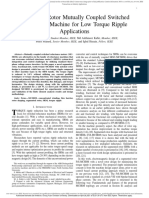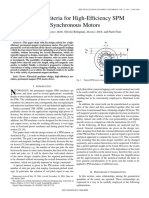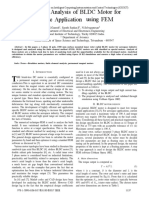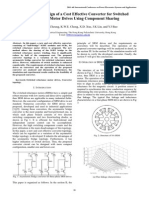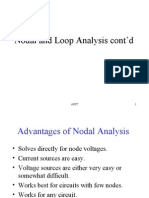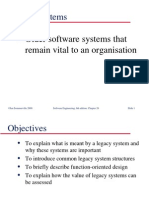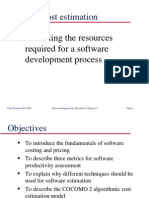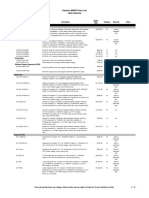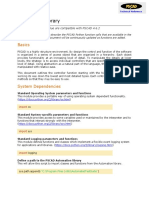IEEE TRANSACTIONS ON MAGNETICS, VOL. 41, NO. 12, DECEMBER 2005 4413
A Novel Switched Reluctance MotorWith C-Core Stators
Shang-Hsun Mao and Mi-Ching Tsai
Department of Mechanical Engineering, National Cheng Kung University, Tainan 701, Taiwan, R.O.C.
This paper presents a novel switched reluctance motor (SRM) design in which the stator is simply formed from C-cores. Unlike con-ventional SRMs, the windings of the new motor can be individually wound into the stator cores without complex winding equipment.Because of the inherent axial fielddistribution, this typeof SRM requires a three-dimensional (3-D) finite-element analysis (FEA) modelfordetailedfluxanalysis.Thispaperproposesanapproximatedtwo-dimensionalFEAmodeltospeedupcomputationaltime.Inaddition,since the proper current that ensures operation in the saturated region (to maximize torque and efficiency) is often hard to determinesystemically, the paper proposes a simple method to determine the optimum operating current. Finally, the paper compares some char-acteristics of a traditional SRM with those of the proposed SRM. The comparison shows that the proposed SRM performs well in termsof torque and efficiency, and provides a higher degree of flexibility in winding design.
Index Terms—
Finite-element analysis, optimum operating current, switched reluctance motor.
I. I
NTRODUCTION
S
WITCHED reluctance motors (SRMs) have been widelyused in many industrial applications such as aerospace, au-tomotive and domestic appliance manufacturing [1]. The majoradvantages of SRMsare hightorque output,widerangeof oper-atingspeed, simplestructureandfault tolerance.Severalanalyt-ical methods for SRM design have been presented [2], [3]. Be-
cause of its inherent nonlinear magnetic characteristics and thedoubly salient pole structure, the finite element analysis (FEA)approach is often adopted for obtaining its accurate magneticcharacteristics [4], [5].
TwoofthemajordesignobjectiveswhendesigningSRMsarehigh efficiency and low cost. Fig. 1 shows the basic structureof a conventional SRM. While the geometry and windings arenot as complex as, say, an induction motor, automated windingof this machine can still be a complex process. Also the per-formance can be limited by the area of the slots and the tight-ness of winding (i.e., the slot-fill and end-winding overhang).For example, if the winding is not tight enough, the end-turnsof winding will cause large copper loss and then the motorefficiency will be reduced. There will also be additional end-winding resistance and leakage inductance which will increasethedemandonthesupply.ThispaperpresentsanovelSRMwitha C-core type of stator for axial winding which is based on [6].Such a structure creates a large slot space so that the windingprocess becomes more straightforward. Also, since the C-corestators are independent of each other, they can be manufacturedandwoundindividuallyandefficientlybyanautomatedprocess.Consequently the cost of winding will be reduced significantly.However, the flux distribution of this new type of SRM is inher-ently three-dimensional (3-D) and hence requires a 3-D finiteelement model for analysis. It is well known that 3-D analysisis very time consuming in simulation so in this paper, a simpli-fiedtwo-dimensional(2-D)analysisoftheoriginal3-Dmodelis
Digital Object Identifier 10.1109/TMAG.2005.858372
proposed in order to speed up the simulation process. The An-soft/Maxwell finite element analysis package [7] is employedfortherequiredsimulationandalsotocalculatethefluxlinkage,inductance and torque.In general, the output torque of an SRM is related to thechange of co-energy so it should be designed to operate intothe saturated region for greater output torque. However, theproblem is how to determine the optimum operating current. Inthis paper, a method is developed to determine the operatingcurrent and turns-per-phase, where the flux linkage is modeledwith a single curve in the unaligned position and two curvesin the aligned position respectively [8]. By calculating themaximum increment of co-energy, the optimum excitationcurrent that produces the maximum increment of torque can bedetermined.This paper is organized as follows. Section II presents the ge-ometry design based on the “feasible” triangle criteria [9]. Asimplified 2-D model is proposed in Section III. Determinationof number of the coil turns and the rated current is given in Sec-tion IV. The characteristics comparison with a traditional SRMis shown in Section V. Section VI concludes the paper.II. M
OTOR
D
ESCRIPTION AND
G
EOMETRY
D
ESIGN
A. Motor Description
The structure of traditional SRM has a radial winding andradial air gap. Let the electric loading be defined as [10](1)where is the number of coil-turns per phase, is the phasecurrent, is the number of phases conducting simultaneously,and is the bore diameter. It can be seen that the product of and isaconstantforagivenelectricloadingandborediameter.However, the winding space is restrained by slot space, numberof turns, area of conductor cross section, insulation thicknessand the maximum manufacturing slot-fill. Obviously, it is dif-ficult to determine the number of turns and phase current in aconfined slot and the design flexibility will be limited by the
0018-9464/$20.00 © 2005 IEEE












